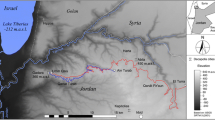Abstract.
This paper describes the longest ancient aqueduct system in the Mediterranean World, built in the 4th century A.D. to supply the city of Constantinople, then capital of the Byzantine Empire. Results are presented from ongoing investigations in the city and hinterland of modern Istanbul by an international team of archaeologists and hydrogeologists. The hydrogeological setting of the region resulted in the development of a unique water supply system, which survives both as archaeological remains and in the writings of contemporary historians.
Similar content being viewed by others
Author information
Authors and Affiliations
Additional information
Electronic Publication
Rights and permissions
About this article
Cite this article
Bono, .P., Crow, .J. & Bayliss, .R. The water supply of Constantinople: archaeology and hydrogeology of an Early Medieval city. Env Geol 40, 1325–1333 (2001). https://doi.org/10.1007/s002540100365
Received:
Accepted:
Issue Date:
DOI: https://doi.org/10.1007/s002540100365




